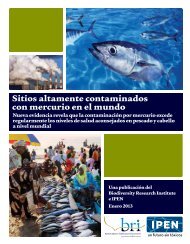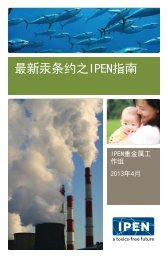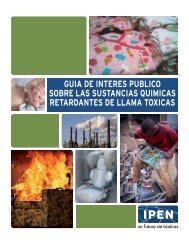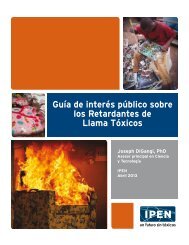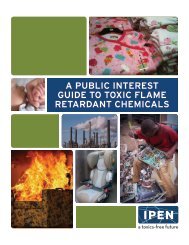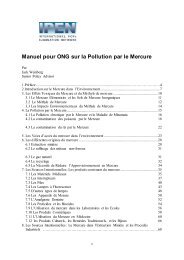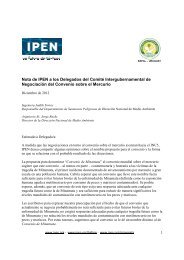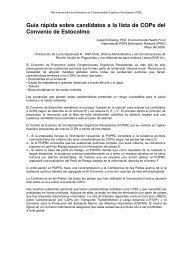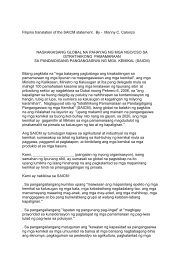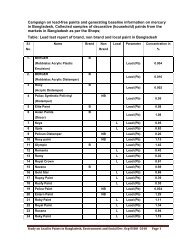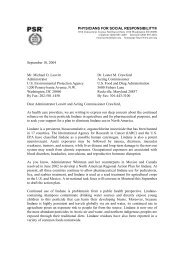The UNDP-GEF POPs Resource Kit - International POPs Elimination ...
The UNDP-GEF POPs Resource Kit - International POPs Elimination ...
The UNDP-GEF POPs Resource Kit - International POPs Elimination ...
Create successful ePaper yourself
Turn your PDF publications into a flip-book with our unique Google optimized e-Paper software.
No country presently reports intentional PCB production. However, some countries<br />
may have PCB stockpiles and may continue using PCBs in some new transformers and in<br />
transformer repair.<br />
Under the Stockholm Conventions, Parties will be required to remove all PCBs from<br />
use by 2025, at the latest. PCB recovery for the purpose of its reuse in other equipment will<br />
be banned, and all PCB export and import will be prohibited except for the purpose of<br />
environmentally sound waste management. Parties will identify and label PCB-containing<br />
equipment, assure the equipment does not leak, and avoid PCB use in applications associated<br />
with processing of food or feed. When PCB-containing articles become wastes, their PCB<br />
content must be appropriately destroyed or disposed in accordance with Convention<br />
provisions.<br />
Polychlorinated Dioxins and Furans. Dioxins and furans are a class of chlorinated<br />
hydrocarbons that have never been commercially or intentionally produced except in small<br />
quantities for laboratory purposes and/or as reference standards. <strong>The</strong>re are 75 different dioxin<br />
cogeners and 135 different furan cogeners.<br />
Dioxins and furans are generated as unwanted byproducts in a variety of combustion<br />
and chemical processes.<br />
All dioxins and furans have similar toxicity, but the different dioxin and furan<br />
cogeners have varying potency. <strong>The</strong>re exists internationally recognized weighting systems<br />
that assign what is called “Toxicity Equivalency Factors” (TEFs) to different cogeners<br />
according to their potency. <strong>The</strong> most potent dioxin – 2,3,7,8,TCDD – is assigned a TEF of<br />
1.0. <strong>The</strong> others are assigned TEFs that are a fraction of 1.0. When a laboratory analyzes a<br />
mixture of dioxins and furans, the quantity of each cogener present is multiplied by its TEF.<br />
<strong>The</strong> results are then summed, and the sum is expressed in terms of Toxic Equivalency (TEQ).<br />
(For example, if a mixture has a TEQ of 22 nanograms of dioxin, this means the mixture has<br />
the same toxic potency as 22 nanograms of pure 2,3,7,8 TCDD.)<br />
Laboratory tests to measure dioxins and furans are presently very difficult and<br />
expensive to perform. Few countries have laboratories with the capacity to perform these<br />
tests.<br />
<strong>The</strong> Stockholm Convention identifies a number of dioxin and furan source categories.<br />
<strong>The</strong>se include: waste incinerators combusting municipal waste, hazardous waste, medical<br />
waste and sewage sludge. Also, cement kilns firing hazardous waste and open burning of<br />
waste, including landfill fires.<br />
Other dioxin and furan source categories are: pulp and paper mills using chlorine<br />
bleach processes; certain thermal processes in the metallurgical industry; some chemical<br />
production processes; and others.<br />
Under the Stockholm Convention, Parties are obliged to take measures to reduce total<br />
dioxin and furan releases with the goal of their continuing minimization and, where feasible,<br />
ultimate elimination.<br />
<strong>The</strong> starting point will be for Parties to develop action plans that will: evaluate current<br />
and projected dioxin and furan releases; review existing laws and policies; and develop<br />
strategies. <strong>The</strong> actions a Party may take to reduce dioxin releases include:<br />
14 ----------------------------------------------------------------------------------------<strong>UNDP</strong>-<strong>GEF</strong> <strong>POPs</strong> <strong>Resource</strong> <strong>Kit</strong>



